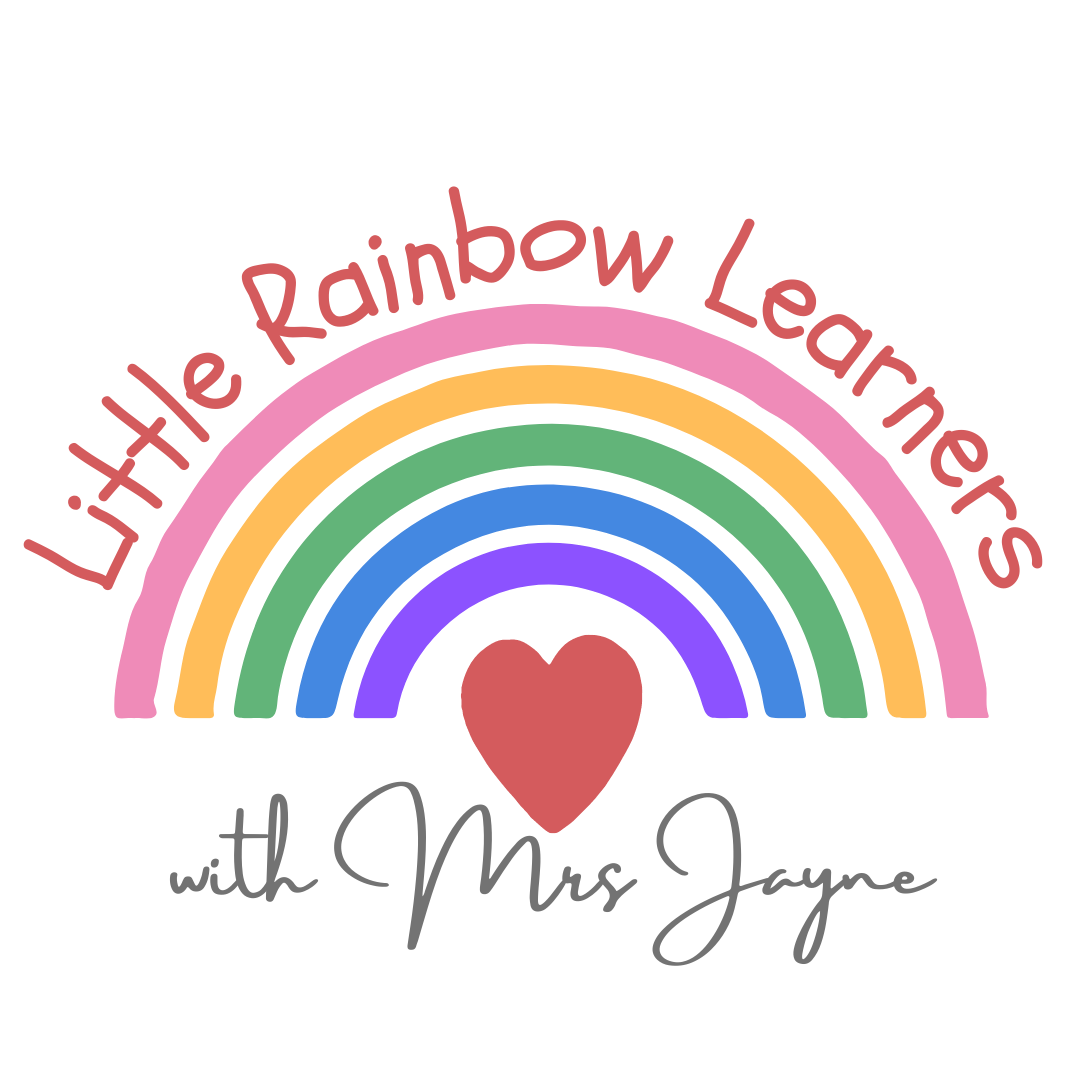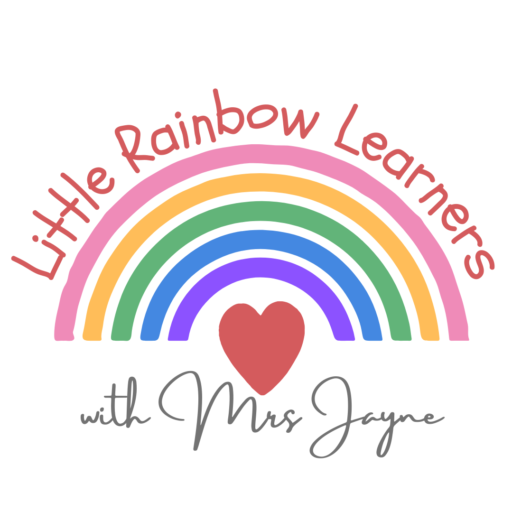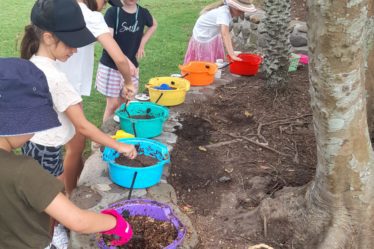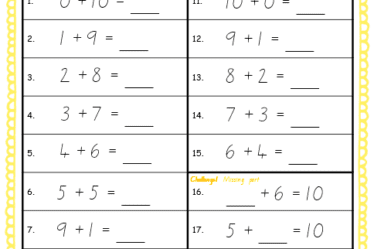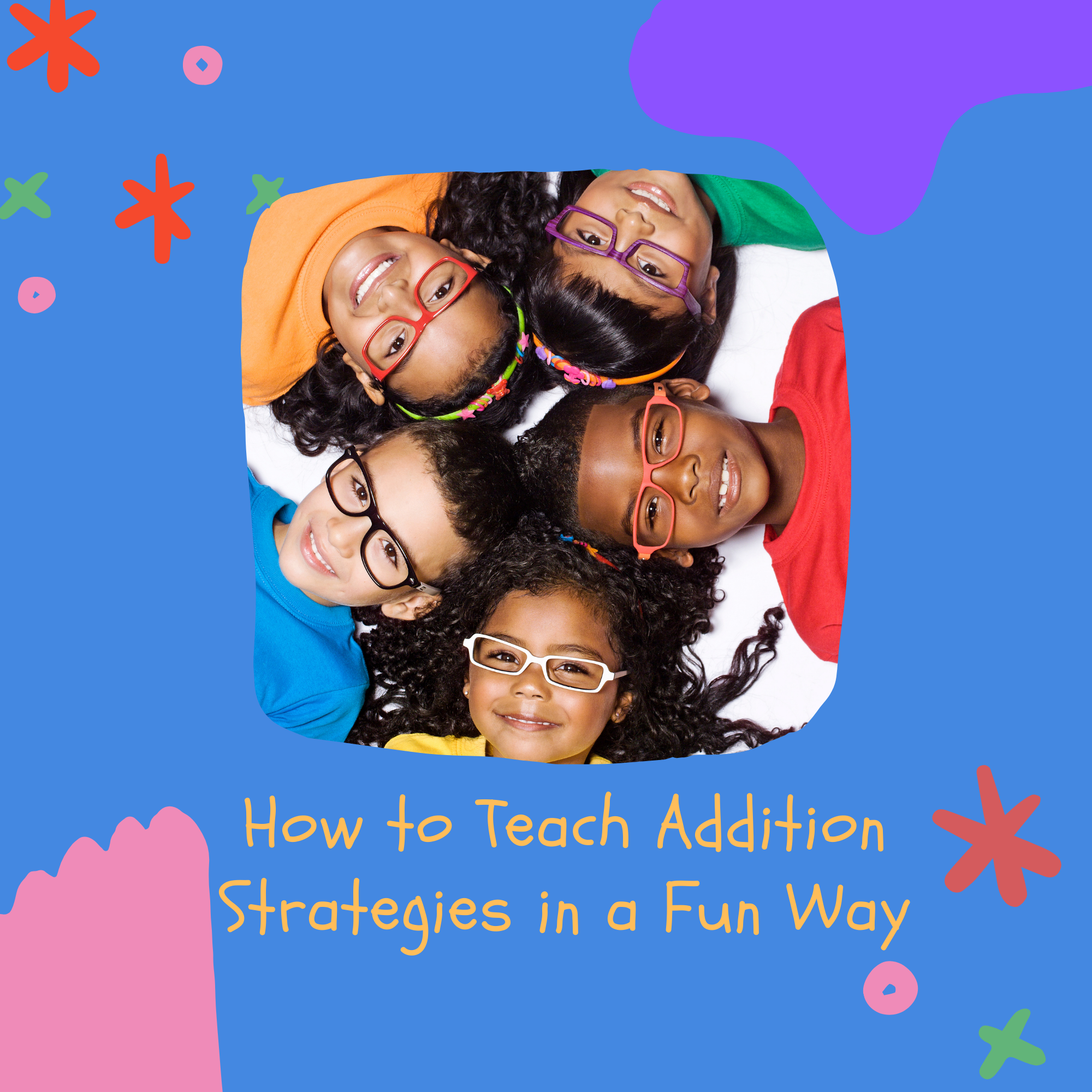
Many Australian Early Childhood teachers know how to teach addition strategies to the young learners in their Year 1 and 2 classes. But what happens as students enter the middle years of primary schooling? Does the need for teaching addition strategies end in Year 3?
Nope!
Here are my top 4 tips:
- Teach (or revise) the 10 basic mental addition strategies explicitly and in order.
- Permanently display addition strategy posters in your classroom.
- Use addition strategy worksheets, games and hands-on materials to practice mental addition strategies in fun and varied ways.
- Apply single-digit addition strategies to problems with larger numbers so children develop efficient mental strategies for computation without a calculator … or their fingers!
If you’re a Year 3 teacher who’s lucky enough to have inherited students who have been taught addition strategies by their teachers in previous years, you’ll certainly have a head start … but don’t underestimate the importance of revising basic mental addition strategies at the start of the year.
If you’re a Year 3 teacher who is introducing addition strategies for the first time, don’t skimp on the basics! Start at square one and cover each of the 10 basic addition strategies explicitly and in order.
The 10 basic mental addition strategies (and the order to teach them in)
- Turnarounds
- Add zero
- Count on
- Rainbow facts
- Add ten
- Doubles
- Near doubles
- Near ten, add nine
- Near ten, add eight
- Bridging ten to teach ‘the leftover’ facts
I always teach these 10 basic addition strategies at a one-per-week pace for the first 10 weeks in Term 1, whether my Year 3 students have learned the strategies previously or not. For those who have been shown the strategies before, revision of the basics is never overkill, especially when we consider how much children tend to forget over the Christmas break!
Reactivating their maths neurons by revisiting the basics is the perfect way to boost their confidence at the start of the year (‘Wow – you guys are smashing this! You’re so ready for the new challenges of Year 3!’) and will set them up for success as your maths lessons move on to more difficult problems with larger numbers (these introductory mental strategies are the basis for all of the trickier strategies they’ll be playing with this year … split strategy, jump strategy, compensation strategy …)
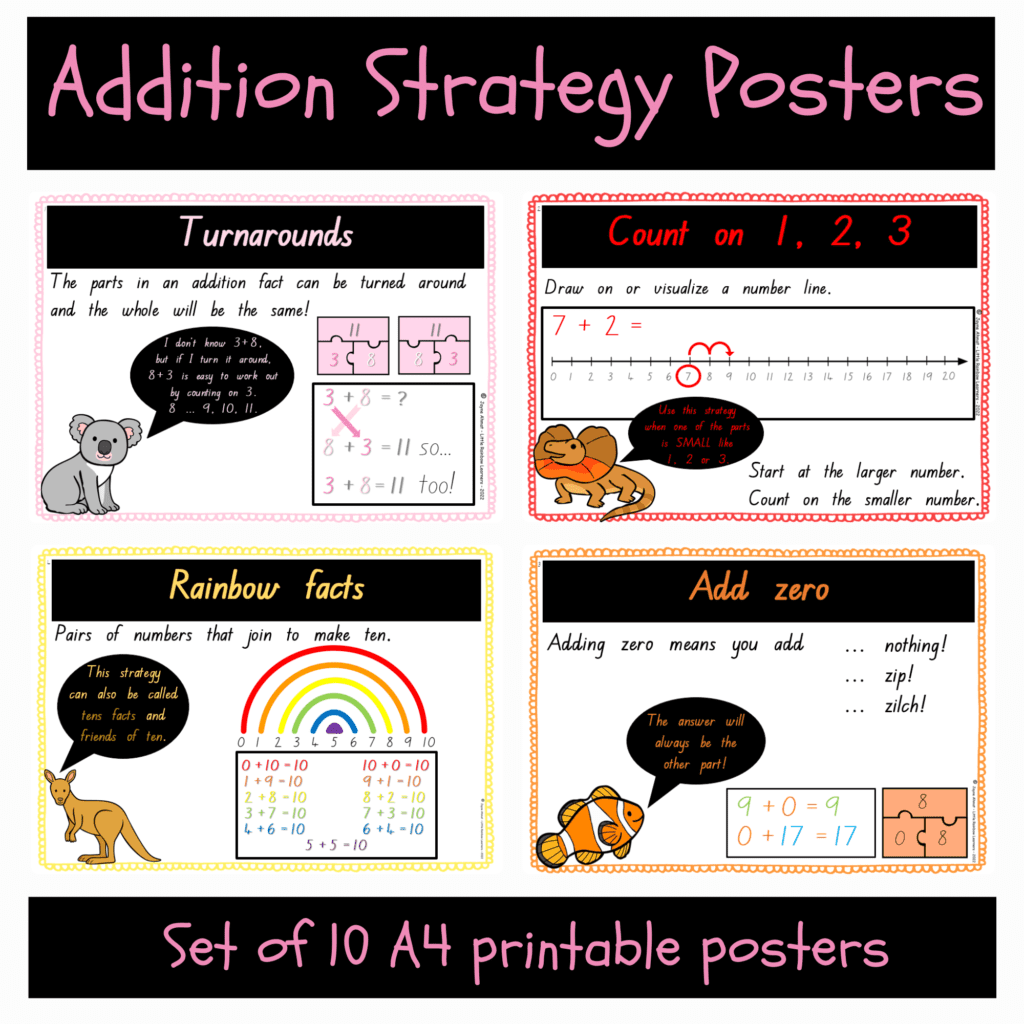
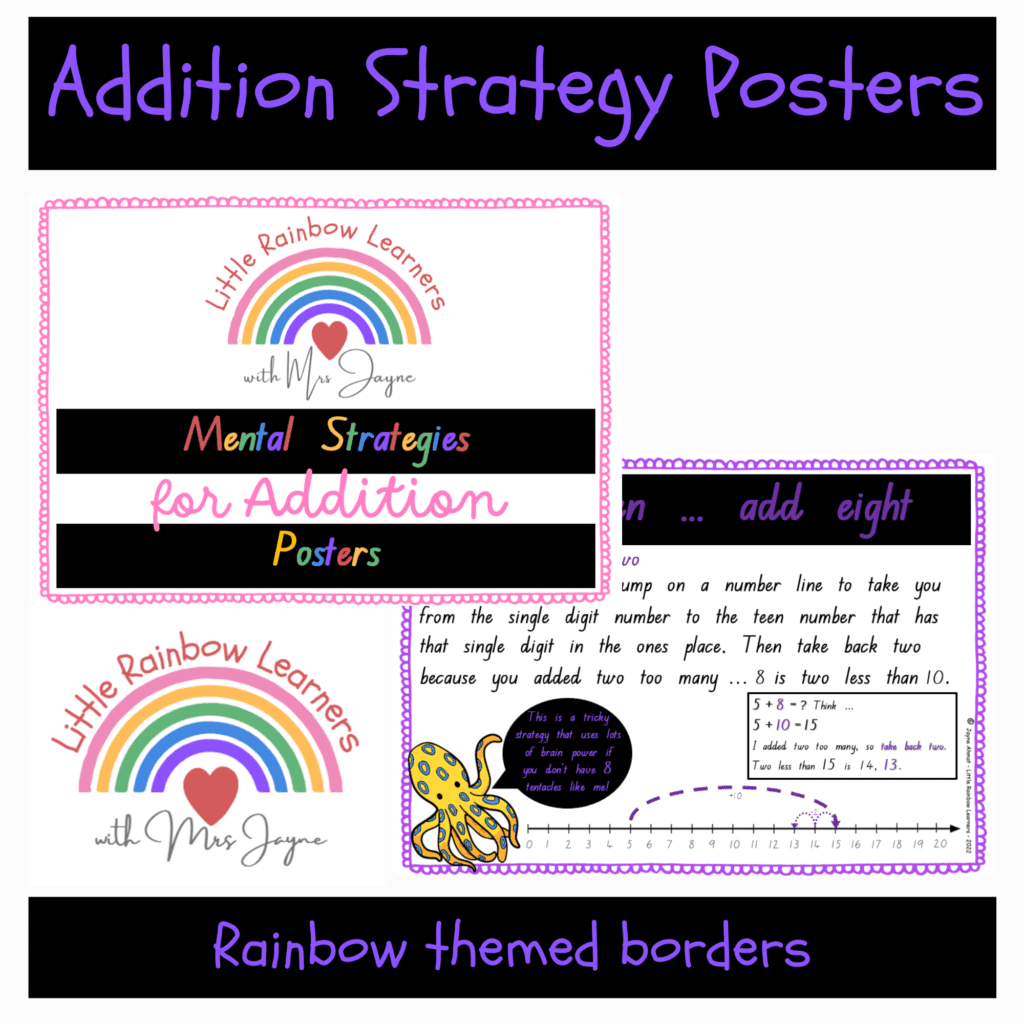
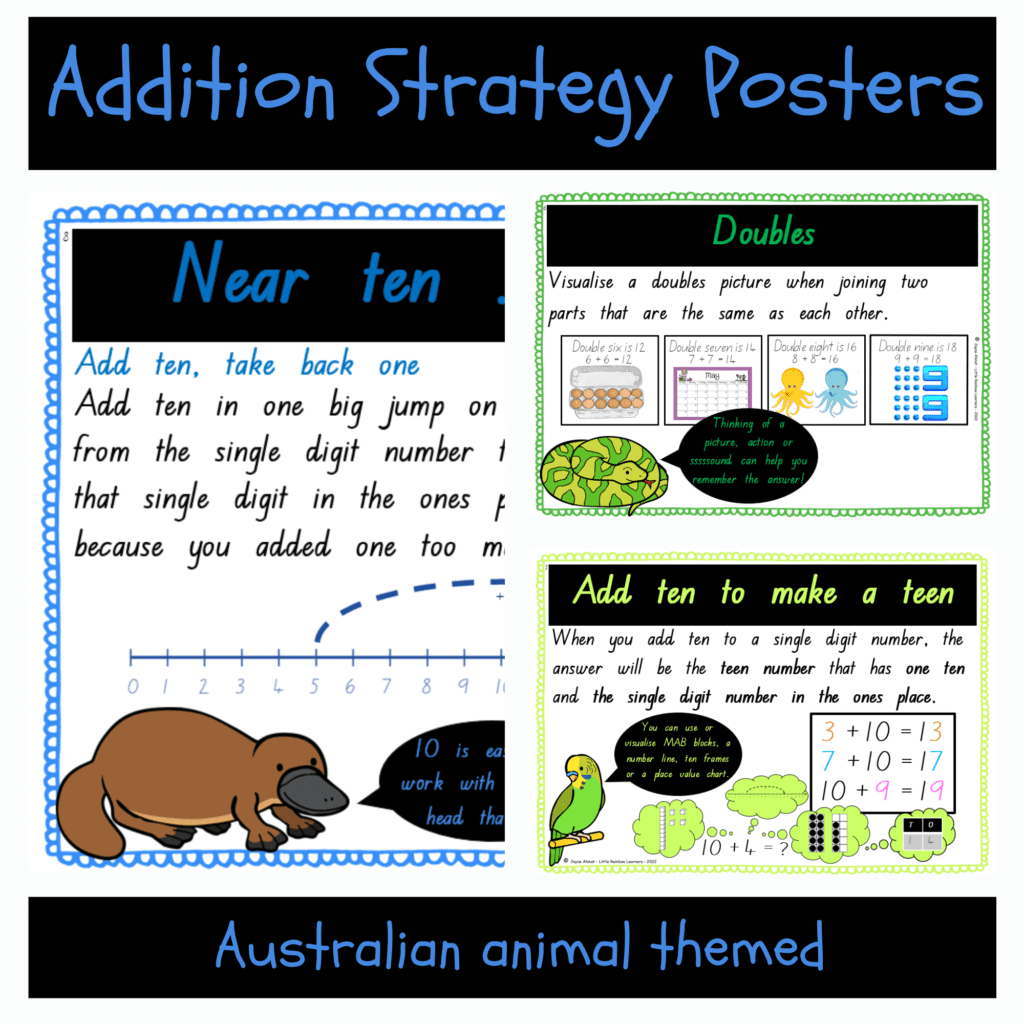
Let’s take a deeper look at the top 4 tips for …
Teaching mental addition strategies Year 3:
1. Teach (or revise) the 10 basic mental addition strategies explicitly and in order.
- Pop one strategy into your maths planning every week in Term 1.
- Explicitly teach the strategy to the whole class on Monday by modeling ‘think aloud’ talk (explain step-by-step what thoughts are going on in your head as you work through a simple number sentence).
- Model the strategy in a variety of ways to catch all of the diverse learners in your class – show the strategy using number sentences, vertical addition, ten frames and counters, part-part-whole models, a number line, a hundreds chart, a place value chart, MABs, diagrams, jottings, think bubbles with written sentences, picture cues, etc …
- Revisit the strategy all week by providing maths group experiences, games, fast-finisher activities, a quiz (and homework if your school requires you to set maths homework tasks) based on the ‘strategy of the week’. See Tip 3 for more ideas.
- Teach what the word ‘strategy’ means. I establish a frequently used call-and-response reminder by saying “a strategy is …” and have children end the sentence with “… a way of working something out” in unison.
2. Permanently display addition strategy posters in your classroom.
- For Year 1 and 2 I like to add one new poster to a maths wall each week as I explicitly introduce each strategy. In a Year 3 classroom, I’d have all 10 posters displayed from day 1 as most students will be familiar with most strategies already. The posters will be a handy reference for them (and you!) as everyone’s brains get back into gear in January!
- Leave the posters up all year, though changing their position in the classroom occasionally will freshen things up and mean the posters don’t fade into the background and become ‘unnoticeable wallpaper’.
- If you’d like a set of rainbow-coloured, Australian-themed posters that match to worksheets, games, foldable mini books and chatterboxes, then check out these addition strategy posters in my TpT store.
- I also display a poster printed with “A strategy is … a way of working something out … or … a way of solving a problem” on permanent display.
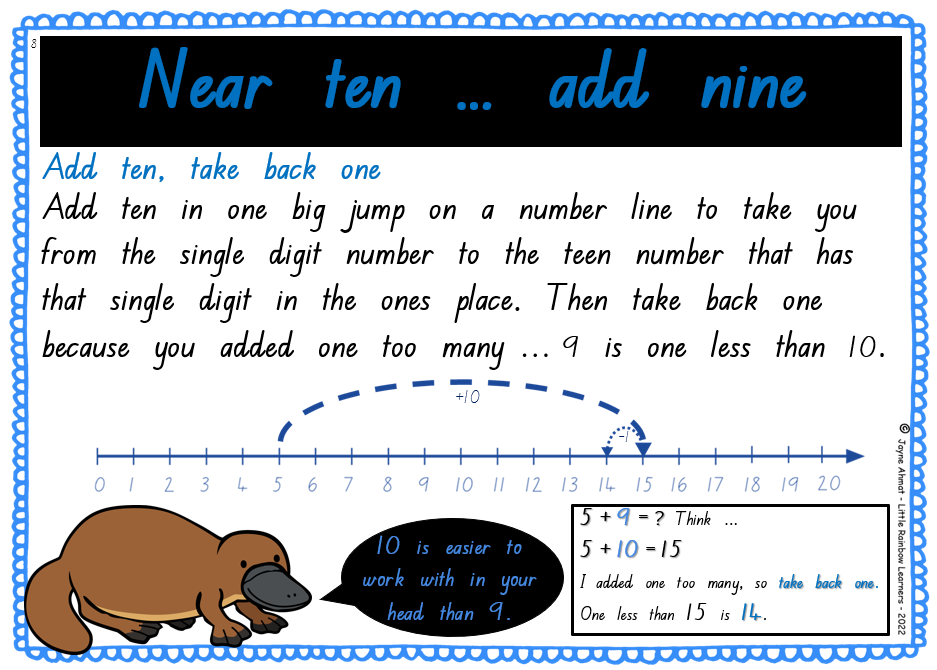
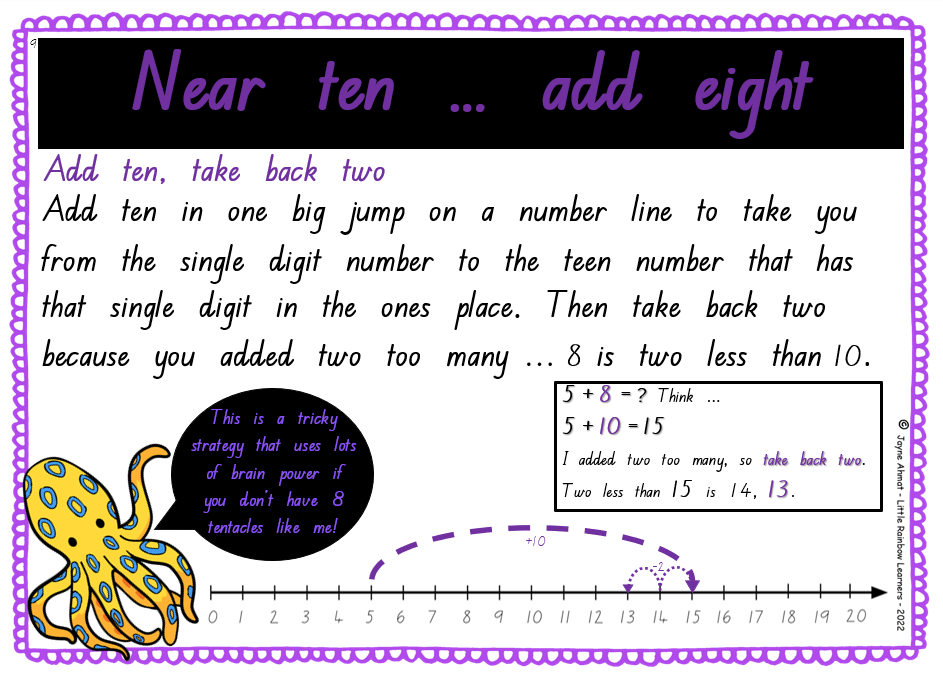
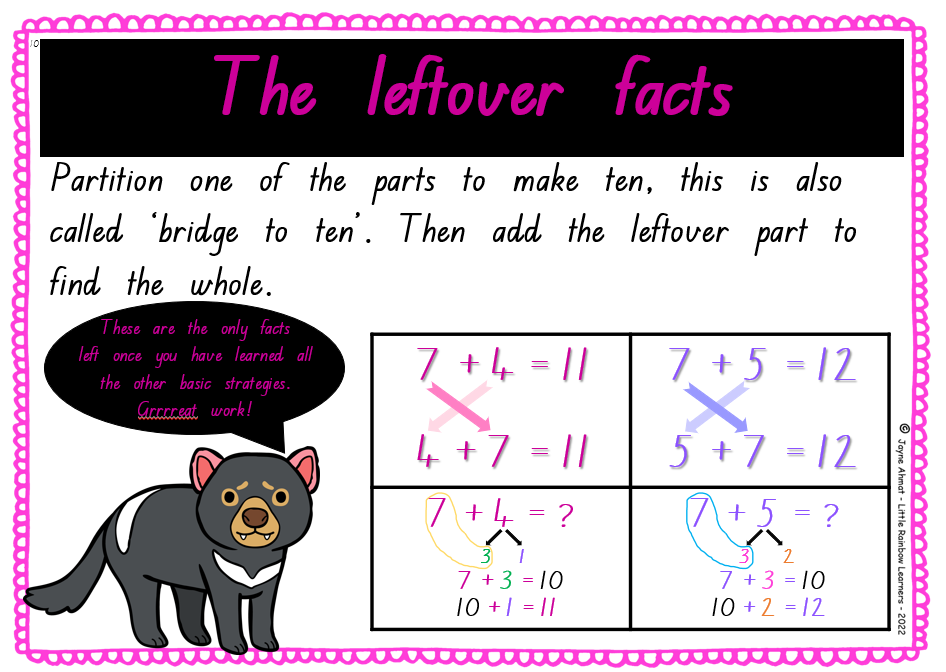
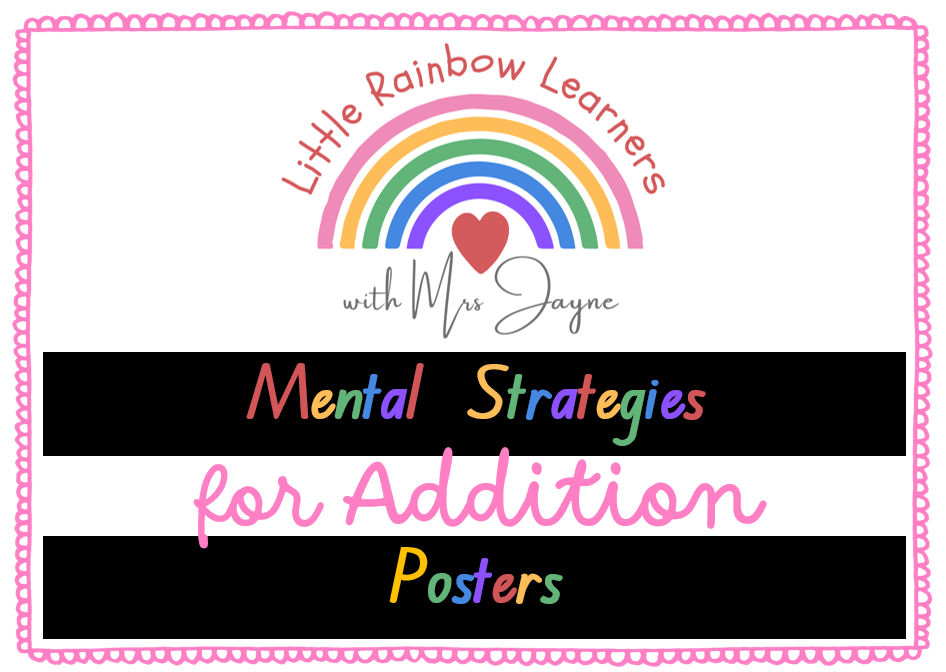
3. Use addition strategy worksheets, games and hands-on materials to practice mental addition strategies in fun and varied ways.
- Kids love a good drill-and-skill worksheet! Many students enjoy the added challenge and excitement of being timed while completing a worksheet that has a familiar, repetitive format. Try these addition strategy worksheets from my TpT store. They are colour-coded, Australian animal themed, sequential and differentiated.
- Differentiated worksheets allow everyone in the class to be working on the same concept with worksheets that look the same, but with content varied in volume and difficulty to suit learner’s needs.
- Worksheets can be used on Monday after the teacher’s whole-class explicit modeling of the strategy or as part of small group work during the week.
- Encourage students to independently access hands-on materials as needed. A shelf with labeled containers of laminated number lines and hundreds grids, MAB blocks, place value charts, counters and ten frames should be open permanently and in constant use. Praise students who access materials independently. Students who need consistent access to hands-on materials can also have a stash in their desk to access quickly and regularly.
- Games and fun paper-based tasks such as addition strategy chatterboxes and mini foldable books are perfect for maths group rotations or fast-finishers. They require minimal preparation by the teacher and can be kept in labeled containers or folders so the target strategy for the week can be practiced in a variety of ways. Chatterboxes can be used with a partner or small group of 3-4 students for learning that is interactive, social and involves peer-tutoring.
- Chatterboxes, mini foldable books and worksheets are easy, low-prep resources that can be used as homework tasks too. I’ve always found parents to be grateful for maths homework tasks that explain what their child is learning and how to teach it – a strategy-based approach to teaching addition allows for this. I show parents where the paper-based resources are kept in the classroom and offer them self-service access. There are a few parents each year who either ask for extra homework for their child, or want to help their struggling child with maths revision at home.
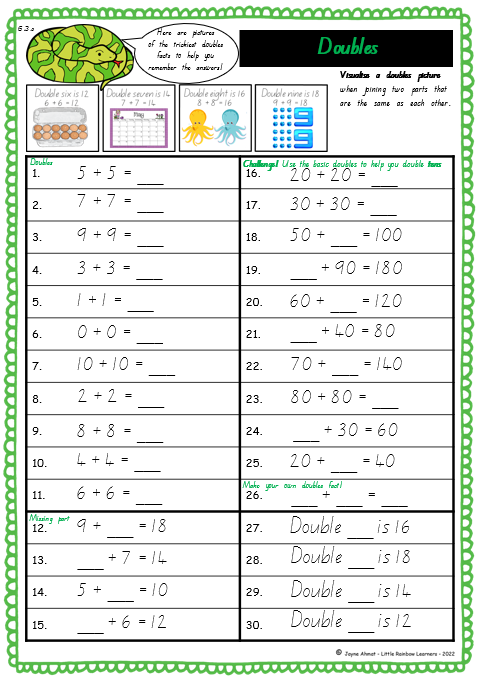
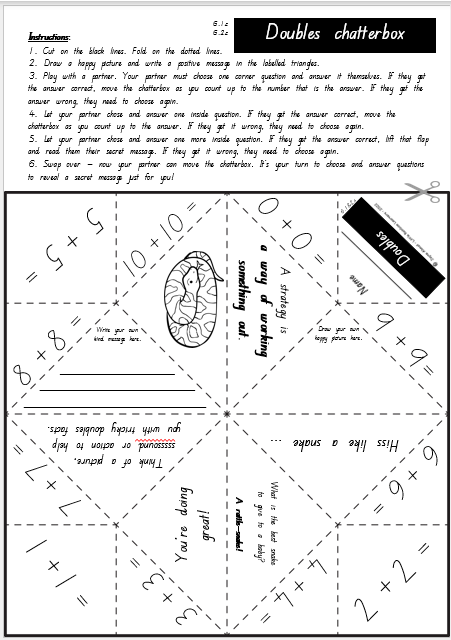
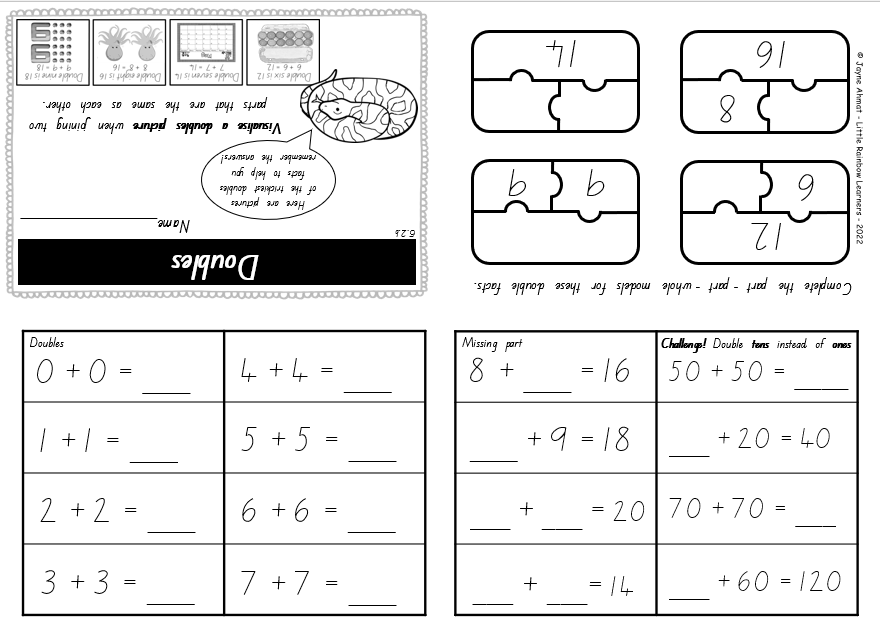

4. Apply single-digit addition strategies to problems with larger numbers so children develop efficient mental strategies for computation without a calculator.
- This hot tip is also mentioned in the new Version 9 on the National Maths Curriculum for Year 3! Once the basic addition strategies have been introduced / revised, you will find they apply to all sorts of more complicated maths scenarios.
- Keep modeling ‘think aloud’ addition strategy talk as you step through addition problems with larger numbers. Make explicit to students that they can use their knowledge of the basic mental strategies – counting on, rainbow fact partitioning to bridge ten, the doubles – to add 2 and 3 digit numbers.
What the Australian Curriculum Version 9 says about teaching addition strategies in Year 3:
All of the skills developed in the Early Years are revised and extended as little learners move into middle and upper primary schooling and eventually into secondary level education.
The Year 3 Mathematics Year Level Description in version 9 of the Australian National Curriculum states:
Students further develop proficiency and positive dispositions towards mathematics and its use as they:
- experience the power of being able to manipulate numbers using a range of strategies that are based on proficiency with single-digit addition facts
- develop, extend and apply their addition and multiplication facts and related facts for subtraction and division through recognising connections between operations
- learn to formulate, choose and use calculation strategies
And the Year 3 Achievement Standard outlines:
- Students extend and use single-digit addition and related subtraction facts and apply additive strategies to model and solve problems involving two- and three-digit numbers.
- They use mathematical modelling to solve practical problems … using a range of strategies
- Students find unknown values in number sentences involving addition and subtraction.
Year 3 Content Descriptors in the Algebra Strand that rely on earlier knowledge of addition strategies are:
AC9M3A01
recognise and explain the connection between addition and subtraction as inverse operations, apply to partition numbers and find unknown values in number sentence
And in the content elaborations, this is further detailed as:
“partitioning numbers using materials, part-part-whole diagrams or bar models, and recording addition and subtraction facts for each representation, explaining how each fact is connected to the materials, diagrams or models; for example, 16+8=24, 24 – 8=16, 8=24 – 16”
AC9M3A02
extend and apply knowledge of addition and subtraction facts to 20 to develop efficient mental strategies for computation with larger numbers without a calculator
And in the content elaborations, this is further detailed as:
“partitioning using materials and part-part-whole diagrams to develop subtraction facts related to addition facts, such as 8+7=15 therefore, 15 – 7=8 and 15 – 8=7”;
“using partitioning to develop and record facts systematically; for example, “How many ways can 12 monkeys be spread among 2 trees?”, 12=12+0, 12=11+1, 12=10+2, 12=9+3, …; explaining how they know they have found all possible partitions”;
“understanding basic addition and related subtraction facts and using extensions to these facts; for example, 6+6=12,16+6=22,6+7=13,16+7=23, and 60+60=120,600+600=1200”.
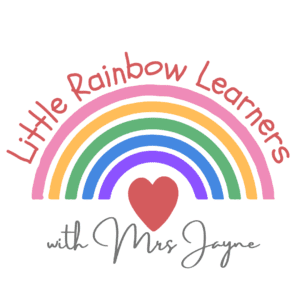
My favourite sentence in version 9 of the Year 3 Mathematics curriculum is:
“experience the power of being able to manipulate numbers using a range of strategies that are based on proficiency with single-digit addition facts”!
ACARA, 2022
What a powerful statement from ACARA (Australian Curriculum & Assessment Authority, the author of Australia’s National Curriculum). This proclamation verifies the importance of building solid foundations in the Early Years by teaching our little learners the full suite of mental addition strategies – strategies that will be applied in countless maths situations as our lifelong learners continue to grow.
Mrs Jayne
xo
Related Articles:
Refer directly to version 9 of the curriculum for Australian Year 3 Maths here:
Mathematics – Year 3 (australiancurriculum.edu.au)
Read an informative research paper about the importance of developing mental strategies rather than relying on counting to solve addition, published by Australia’s Monash University, here:
